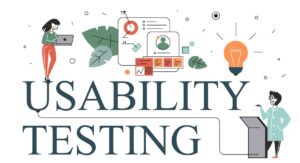UI (user interface) and UX (user experience) are often used interchangeably, and some job descriptions, such as those for UI/UX designers, call for skills in both areas. But although UI and UX designers work closely to ensure that users have the best possible interactions with the products they buy, these two fields have different roles to play in designing and developing new products. Here’s a look at the key differences between UI and UX design, what skills you’ll need to find work in this fast-growing and lucrative space, and how online UI/UX design courses can help you gain those.
What Are UI and UX?
User interface and user experience design and research have the same focus: creating user interfaces that make it as easy as possible to use a product, digital or otherwise. They also require similar skills: empathy, communication, and an eye for design. But UI is just one aspect of the larger goal of delivering an optimal user experience.
UI: The “Nuts and Bolts” of the User Experience
User interface design arises from a major shift in the early days of computing when computers were almost exclusively the domain of programmers and coders. At that time, users interacted with computers via the command line interface, which required knowledge of programming languages, and commands were executed through strings of code. But in the 1980s, a very different model appeared: the graphical user interface, or GUI. This interface used graphic elements, such as icons and buttons, so that users could communicate with computers without programming or coding knowledge.
The development of the GUI meant that computer interfaces had to be designed with end users in mind—ordinary people who needed tools to interact quickly and easily with their devices. With that in mind, user interface design was born, a subspecialty focused exclusively on developing the many elements that create smooth interactions with computers.
Although UI design was originally applied only to computer interfaces, today, it extends to various digital devices, including mobile apps, wearable tech, and smart appliances. The UI design process is practical and strategic, and UI designers work to create interactive elements and responsive design that make the user’s journey as easy as possible, whether that involves navigating a website, using an app, or programming a home security system.
Also Read: What is UX UI Design? A Beginner’s Guide
UX: Building the Complete User Experience
If UI is dedicated to designing the visual interface elements that create a satisfactory user experience, UX designers focus on the many ways a user interacts with a product. That includes whether users can find the right navigational tools and how they feel about their overall interaction with the product and the brand that stands behind it. UX designers focus on ways to improve a user’s journey with products of all kinds, incorporating user research about every aspect of that journey.
UX design aims to eliminate barriers to user satisfaction and find better ways to offer solutions to the problems they’re seeking to solve. In that way, UX design operates on multiple levels to create a positive experience that includes more than practical functionality.
UX researchers gather concrete data (numbers and statistics) and users’ impressions about a product using surveys, interviews, and observation of people performing specific tasks. UX designers then use this research as a guide to create products that meet users’ expectations.
UI and UX: Complementary Paths to User Satisfaction
For years, designers have debated the difference between UI and UX design, trying to find a framework for understanding their relationship. Adding to the confusion are the many job titles for professionals in the UI/UX design space, such as content designer, UI/UX designer, interaction designer, and user experience architect.
But UI design is simply one component of creating an overall user experience. For a simple analogy, think about building a house. UX design is the foundation and the four walls, while UI is the paint and furnishings that make it convenient for living.
That relationship between UX and UI design is clear in the familiar home screen of Google, with its clean interface designed to do just one thing: make it easy for anyone to search for information. The streamlined, minimal UI and uncluttered space create a UX that makes Google the go-to name for web searching, one so familiar that it’s even become a verb.
Tasks and Responsibilities: What Do UI and UX Designers Do?
Both UX and UI designers share many skills and duties, but their work takes place at different places in the product development process. In this respect, let’s dig into the difference between UI and UX design.
UI Design: Visual Elements for Easy Interactivity
Originally, UI design was applied exclusively to the graphic elements on the screens of digital devices. Today, that definition has extended to the visual design of interfaces for other devices. But, in all its forms, UI designers work on creating the visual elements that allow a user to access and navigate the properties of products ranging from laptops to smart thermostats.
UI designers aim to create a user experience so intuitive and natural that it’s hardly noticed and that gets users the outcome they want quickly and smoothly. To create those elements, UI designers need some knowledge of graphic design, such as typography, color theory, and white space. Working with the insights revealed by the “big picture” of UX research, UI designers put themselves in the place of a potential user, imagining what elements will make the product easy to use, such as placing a button in a prominent place on a webpage.
UI designers collaborate with other design team members, particularly the UX designer, if those jobs are separate. Their work begins with insights from UX research and continues as design prototypes are tested and refined. The work of UI designers centers on understanding and applying the principles of visual design to every element users will encounter when interacting with the product. That could include designing individual screens and pages for websites and apps and all the visual elements they contain, such as sliders, icons, and buttons.
Because UI designers create all the visual elements in user interfaces, their work includes developing color palettes, choosing fonts, and establishing a consistent style across all product parts. After making those decisions, the UI designer will create a mockup or wireframe to share with developers and UX designers and work with them to get to a final design.
Also Read: A 2023 Guide to UX UI Design Companies
UX Design: Putting It All Together
UX designers work with UX researchers, UI designers, and other members of the design and development teams to create products that meet user needs and expectations. UX design informs a product’s life cycle, from concept to finished product. The UX design process may also include research that reveals what users want and need in a product.
Guided by the insights of UX research, UX designers develop prototypes for testing product designs and continue to refine them through repeated trials until the best version is ready for release. UX designer responsibilities include working with UX research data, collaborating with other teams to create prototypes and models for testing, and communicating with people, including end users, developers, and other stakeholders in the organization, at all stages of the design process.
What Skills Are Required for a Career in UI/UX Design?
Whether you’re interested in becoming a UI or UX design specialist through online UI/UX training or your ideal position combines the differences between UI and UX design, you’ll need a broad combination of “soft” skills and technical knowledge to succeed. These can include:
Empathy and Imagination
UI/UX designers need to be able to put themselves into the position of users and imagine what features would make it easy to use a product. They must be sensitive to users’ “pain points” and needs and follow users through their journey.
Communication Skills
Both UI and UX designers need to be able to communicate with other design and development teams through all the stages of the design process, as well as with other stakeholders in the company, including decision-makers and marketing and sales teams.
Design Skills
UI/UX designers need to know design basics, including color theory, typography, and layout, for creating mockups and prototypes. That can include basic graphic design skills and some knowledge of visual arts as well as website and webpage design.
Software and Computer Skills
To create design prototypes, UI/UX designers need some familiarity with design and modeling software. Experience with wireframing, animation, 3D modeling, and web design can also be helpful.
Are You Interested in a Career in UI and UX Design?
UI/UX design is a broad field with subspecialties that include research, writing, and data management, and it offers opportunities in industries of all kinds. Today, specialized bootcamps and professional certification programs target the skills you need to find work in this fast-growing field. With the UI UX Online Bootcamp delivered by Simplilearn in collaboration with the University of Massachusetts, you can become a certified UI/UX designer and build your portfolio in just five months, with additional job assistance to find the right position.
You might also like to read:
What is a UI Developer? A Comprehensive Guide
Tips on How to Improve the UI/UX of a Website
How to Become a UI/UX Designer? Responsibilities, Skills & Everything You Should Know in 2023
A Comprehensive Guide to UI UX Interview Questions
UI UX Designer Job Description: What Does UI UX Designer Do?







